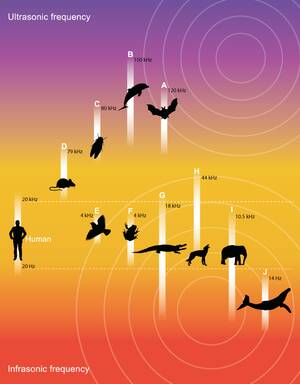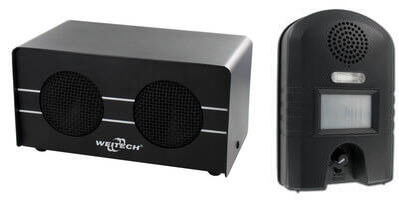Ultrasonic animal repellers emit ultrasonic waves, inaudible to humans, that manage to repel certain animals such as cats, rats, mice, rabbits, squirrels, martens, ferrets… without the need for potentially dangerous chemicals.
Contents:
- What are ultrasounds?
- What is the difference between an ultrasonic repeller and an audible repeller?
- Are ultrasounds bothersome to people?
- Are ultrasonic repellers effective for pigeons and other birds?
- Do ultrasonic repellers work to repel cats, rats, mice, and other animals?
- Top 2 Ultrasonic Animal Repellers
- Usage Tips: Where to place the ultrasonic animal repeller?
- Ultrasonic Animal Repellers – Customer Reviews
What are ultrasonics?
There are two key parameters for classifying a sound: volume and frequency:
- Sound volume, or intensity, is measured in decibels (dB). People can hear from 0 dB. A conversation between people is usually around 60 dB. And the sound of fireworks is around 160 dB.
- Sound frequency, or pitch, is measured in hertz (Hz) or kilohertz (kHz). A low sound frequency is perceived by the human ear as a low pitch. A high frequency as a high pitch.
Sound waves can be classified into three main groups based on their frequency:
- Infrasound consists of sound waves with a frequency below 20 Hz. This frequency cannot be detected by humans.
- Audible sounds are sound waves with a frequency between 20 Hz and 20 kHz. This is the normal hearing range for humans.
- Ultrasound refers to sound waves with a frequency above 20 kHz. This frequency cannot be detected by humans, but it can be perceived by most animals.
What is the difference between an ultrasonic repellent and a sound repellent?
- Ultrasonic repellents emit sound waves at a frequency above 20 kHz (ultrasonic waves), which are perceived by most animals but not by the human ear.
- Sound repellents emit sound waves at a frequency between 20 Hz and 20 kHz, within the normal hearing range for humans.
Do ultrasonic repellers bother people?
No, most people cannot hear ultrasonic sounds. The normal hearing range for an adult person is between 20 Hz and 20 kHz. Ultrasonic sounds are sound waves above 20 kHz, which are not perceived by most people. However, children and young people tend to have a higher hearing capacity than adults and can perceive sounds at higher frequencies.
Are ultrasonic sounds effective for pigeons and other birds?
No, birds do not hear ultrasonic sounds, and ultrasonic repellers are not effective in the long term for repelling pigeons or other birds. The hearing range of most birds is between 1 kHz and 4 kHz.
Do ultrasonic repellers work for repelling cats, rats, mice, and other animals?
Yes, ultrasonic repellers are effective in repelling cats, rats, mice, squirrels, rabbits, martens, ferrets… Most animals can detect very high frequencies, ultrasonic sounds that are imperceptible to the human ear. Their auditory system is crucial to their survival instinct. Typically, these animals detect the threat of predators by hearing them before seeing them. Ultrasonic signals affect their environment, feeding habits, communication, relationships, and sense of direction. Animals change their territory.
Very important: For an ultrasonic repeller to be effective, it must meet two criteria:
- Operate at the appropriate frequency level (Hz) for the animal to be repelled
- Operate at a sufficiently intense volume (dB) to disturb the habits of the animal to be repelled and cause it to leave the area.
Below is a list of the frequency levels of the auditory system for the following animals:

- Cats: 30 Hz – 64 kHz
- Rats, Mice: 900 Hz – 79 kHz
- Wild Boars: 42 Hz – 40 kHz
- Rabbits: 360 Hz – 42 kHz
- Insects: 10 kHz – 80 kHz
- Moles: 65 Hz – 12 kHz. Moles are not sensitive to ultrasonic sounds.
- Deer: 20 Hz – 20 kHz. Deer are not sensitive to ultrasonic sounds.
- Dogs: 10 kHz – 45 kHz
- Squirrels: 113 Hz – 49 kHz
- Foxes: 900 Hz – 34 kHz
- Bats: 1 kHz – 120 kHz
The 2 best ultrasonic repellents
There are two main types of ultrasonic animal repellents:
- Ultrasonic repellents that emit ultrasonic sounds constantly.
- These are usually used in closed or semi-closed areas to repel rats, mice, etc.
- The environment becomes hostile for them, the animals feel uncomfortable, threatened, and eventually leave the area.
- Ultrasonic repellents that detect the presence of the animal and then emit an ultrasonic beep.
- These are usually used in open areas to repel cats, squirrels, rabbits, martens, etc., that occasionally access an area we want to protect, such as a tree, garden, orchard…
- When the animal approaches the area, the repellent detects it, triggers an ultrasonic beep that scares the animal and teaches it to avoid that area.
The ultrasonic repellents available in the BirdGard Iberia store combine frequency and intensity. The 2 best and top-selling ultrasonic repellents are:
- Repellent for rats and mice… for indoor use. Model WK0600
- Repellent for cats, rabbits, squirrels, martens… for outdoor use. Model WK0052
Usage Tips. Where to place the ultrasonic animal repellent?
- The location of the ultrasonic repellent is essential for achieving good results.
- Follow the recommendations carefully as indicated in the ultrasonic repellent’s instruction manual, depending on the animal to be repelled.
- To repel rats or mice, it is recommended that the repellent be placed near the area where they enter to look for food.
- To repel cats, rabbits, squirrels, martens… outdoors, it is recommended to place the repellent at the animal’s entry point to the garden, tree, chicken coop, or orchard you want to protect.
- Keep in mind that ultrasonic waves do not penetrate furniture, walls, ceilings, or floors but instead bounce off them.
- Thick rugs and curtains absorb ultrasonic waves.
Ultrasonic Animal Repellents – Customer Reviews
- How to repel Martens and Squirrels. Miguel explains how he managed to repel a marten that attacked his chicken coop and squirrels that left him without hazelnuts, using the WK0052 repellent.
- How to repel Cats
- How to keep Rabbits away from the vegetable garden – Benito Sánchez’s experience.
- How to repel Mice in a village house
